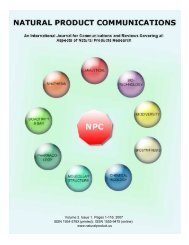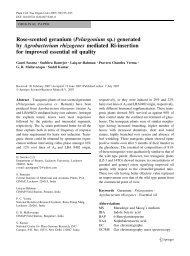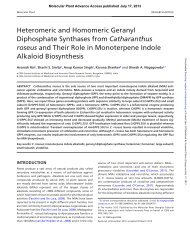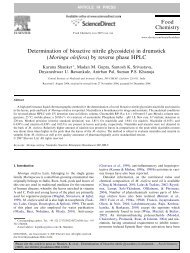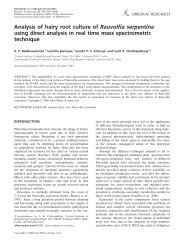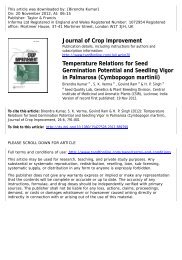Virendra Shukla, Suresh C. Phulara, Deepti Yadav ... - CIMAP Staff
Virendra Shukla, Suresh C. Phulara, Deepti Yadav ... - CIMAP Staff
Virendra Shukla, Suresh C. Phulara, Deepti Yadav ... - CIMAP Staff
Create successful ePaper yourself
Turn your PDF publications into a flip-book with our unique Google optimized e-Paper software.
4 CNS & Neurological Disorders - Drug Targets, 2012, Vol. 11, No. 8 <strong>Shukla</strong> et al.ROS Detection AssayIntracellular ROS level was determined using a nonfluorescentdye dichlorodihydrofluorescin diacetate (H 2 DCF-DA, Sigma, St. Louis, MO, USA). Worms weresynchronized on NGM plates as described earlier. At day 2of adulthood 30 age synchronized worms were collected in300μl of 0.1%PBST. Worms were washed three times withPBST and the lysate was prepared by equally timedhomogenization and sonication (Branson Sonifier 250, VWRScientific, Suwanee, GA). The homogenized samples weretransferred to 96 well plate and prior to reading, 15μl of10mM H 2 DCF-DA was added to each well. Fluorescentreadings were measured in every 20 minute interval for 2hrs30 min at 37 0 C by using a fluorescent microplate reader(Spectramax M 2, Molecular devices). Excitation was read at485nm and emission was read at 535nm [2].Statistical AnalysisSignificant difference between the lifespan of treated andcontrol worms under both normal and stress conditions wasdetermined using Kaplan-Meier survival assay in MedCalcsoftware. Data other than lifespan were statistically analyzedusing ANOVA in ASSISTAT statistical assistance software.Difference between the data was considered as significant atp 0.05.RESULTSOCC Extends the Mean Lifespan of Wild Type N2WormsTo investigate the effects of OCC supplementation onlongevity, the lifespan of OCC treated worms was comparedwith untreated worms. Worms were observed daily forsurvival by touch provoked method [25]. It was observedthat 20μM concentration of OCC increased the meanlifespan of wild type of worms by 3.31 days which is17.96% greater as compared to the non-treated controlworms (p=0.0001) (Table 2; Fig. 2A). Although the 200μMand 2μM tested concentrations failed to significantlyenhance the mean lifespan of wild type worms at 20 o C, thetreatment with 20μM concentration depicted 13.31%increase in the maximum lifespan of N2 worms (Table 2).OCC Enhances Stress Resistance of C. elegansIncreased longevity has been reportedly associated withimproved survival under stressed conditions [26]. Toinvestigate the longevity promoting ability of OCC underoxidative stress wild-type worms were exposed to 10mMparaquat. In the present experiment it was observed thatOCC pretreated worms were more resistant to parquat incomparison to non-treated control worms (Fig. 3). Theresults revealed that all the observed concentrations of OCCsignificantly enhanced the percent survival of the parquatexposed worms. The worms pretreated with 20μM OCCshowed the highest significant (p < 0.007) survival.OCC Decreases the Intracellular ROS Levels in C.elegansTo evaluate the potential effects of OCC for ROSscavenging, the intracellular free radical levels of wild typeN2 worms was determined. It was observed that all thetested concentrations of OCC significantly reduced ROSgeneration in wild type worms (Fig. 4). The results clearlyindicate that OCC could reduce ROS production as the20μM OCC treated worms reduced 40.1% ROS levels ascompared to untreated control (p < 0.001).OCC Enhanced the Pharyngeal Pumping of C. elegansSpeed of pharynx contraction or pumping is an importantparameter of aging in C. elegans and reduction in pumpingcan induce dietary restriction (DR) like effects in worms[27]. The results showed that OCC concentrations were ableto enhance the rate of pharyngeal pumping in adult day 0 andadult day 5 treated worms (Fig. 5A). The 2μM OCCtreatment was unable to increase the pumping rates in adultday 5 worms while in 200μM and 20μM treated adult day 5Table 2.Effect of OCC on the Lifespan of C. elegansStrainsTreatment(mg/ml)Mean Lifespan ± SE No. of Worms (N) % Change P Value Max. Lifespan ± SE Min. Lifespan ± SEControl 18.42 ± 0.94 140 25 ± 0.71 11.5±0.29N2mev-1 (kn-1)daf-16 (mgDf50)OCC (200) 19.42 ± 0.67 96 5.14 = 0.67 24.66 ± 0.76 15±0.50OCC (20) 21.73 ± 0.65 114 17.96 =0.0001*** 28.33± 1.25 17±0.87OCC (2) 19.94± 1.13 134 8.25 =0.019 28± 1.08 13±1.00Control 15.7± 0.77 100 23.66±0.58 10.33±0.58OCC (20) 15.42±0.65 136 1.7 = 0.36 21.67±1.60 11±0.0Control 16.13± 0.43 166 22.33±1.04 12.33±0.76OCC (20) 15.74±0.45 166 -2.4 = 0.32 21.33±0.28 11.33±0.57Control 17.13 ± 0.45 180 23.25 ± 0.47 10.5 ± 0.50sir-2.1 (ok434)OCC (20) 19.71 ± 0.23 138 15.06




